In-Depth Study of 25 HP Mercury Outboard Lower Units
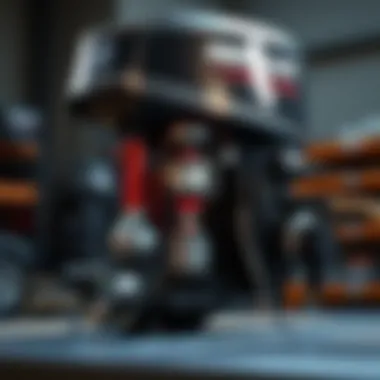
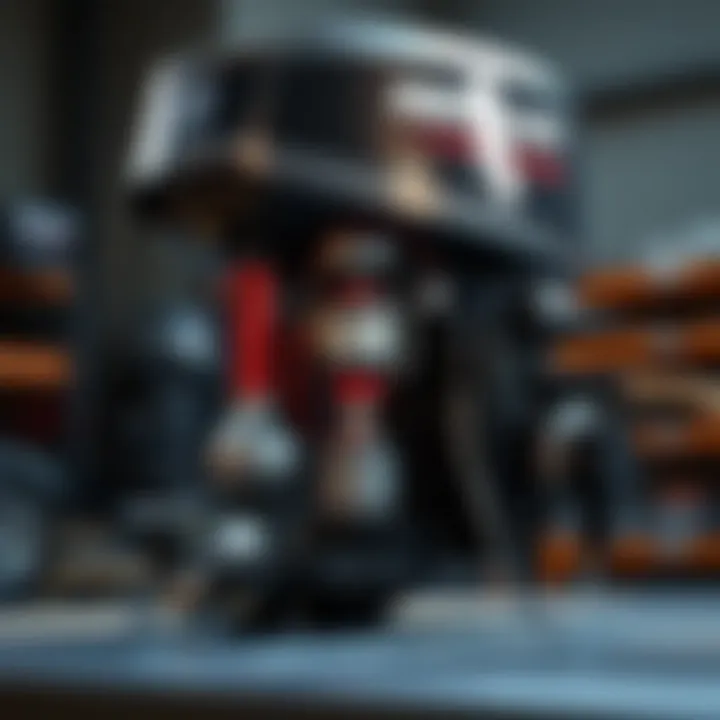
Intro
The lower unit of a 25 HP Mercury outboard motor is a critical component, serving as the interface between the boat and the water. It's like the backbone of your vessel, housing the propeller, gearbox, and several other integral parts. Understanding this unit's design and functionality goes a long way in ensuring smooth performance on the water. In this analysis, we aim to peel back the layers surrounding the lower unit, diving into its quirks, how it meshes with other components, and the common problems users experience.
With marine activities gaining traction among enthusiasts and households, particularly during summer months, having reliable equipment is paramount. If you're setting sail with a Mercury outboard, you'll want to grasp how the lower unit fits into the broader picture of your motor's operation. This article will address the nuts and bolts of the lower unit while offering valuable insights into maintenance practices that keep it in shipshape. Let's set ourselves up with a detailed understanding of the components and their roles before we get into performance evaluations and troubleshooting.
Industry Overview
Current Market Trends
The marine industry has seen a surge in interest, especially in the realm of outboard motors. With eco-friendly boating initiatives and advancements in technology, new models have been rolled out, focusing on efficiency and performance. The 25 HP Mercury outboard, for instance, stands out due to its blend of affordability and power, making it a popular choice among casual boaters as well as serious fishing aficionados.
Consumers today are increasingly inclined to prioritize not just horsepower, but also durability and serviceability. As regulations shift towards stricter environmental measures, manufacturers are innovating to create products that minimize emissions while maximizing thrust. This changing landscape is one to watch; if you own or are considering getting a 25 HP Mercury, staying updated on market trends can enhance your understanding of what to expect.
Key Players and Competitors
While Mercury dominates with its 25 HP outboard, it's essential to be aware of other competitors in the field. Brands like Yamaha and Honda are notable players offering similar horsepower models. Each has unique features and performance metrics, and while Mercury's lower unit is renowned for its engineering, exploring what competitors offer can give you a clearer picture of the market landscape. Being informed about these brands not only guides your purchasing choice but can also impact maintenance strategies as different models have varying parts availability and service requirements.
The competitive dynamics are continually evolving, and looking ahead, we see new features, like digital monitoring systems and enhanced materials for longevity, becoming common across brands.
Recommendations for Consumers
Best Practices for Evaluating Outboard Motors
When in the market for an outboard motor like the 25 HP Mercury, here are some recommendations worth considering:
- Research Specifications: Knowledge is power. Examine the specifications to understand what you are getting beyond the horsepower.
- Read Consumer Reviews: Websites like Reddit and Facebook can be goldmines for genuine user experiences and feedback.
- Check Warranty Terms: The warranty reflects the manufacturer's confidence in their product. Extend it if possible for peace of mind.
How to Use Ratings Effectively
Ratings can provide choice guidance, but knowing how to interpret them is key:
- Look Beyond the Numbers: A high rating does not always mean the best fit. Contextualize ratings in your personal needs.
- Consider the Source: Some reviews might be biased or sponsored. Trustworthy platforms often have strict criteria for verifying user feedback.
- Ask for Local Insights: If you notice common issues from local boaters regarding a specific model, it’s wise to heed those warnings.
As we gear up to explore more about the lower unit specifically, consider how these market trends, best practices, and competitors influence your experience and choices as a marine enthusiast. Stay tuned as we delve deeper.
Prelude to Mercury Outboard Motors
Mercury Outboard Motors have been a significant player in the marine industry, serving as a reliable choice for boaters across various watercraft applications. Understanding the genesis and evolution of these motors is crucial, as it provides insight into their performance, reliability, and user satisfaction.
The story of Mercury Outboards spans decades, marked by innovation, adaptation, and unwavering commitment to quality. From humble beginnings, these engines have evolved into some of the industry’s most trusted products, reflective of advancements in engineering and technology.
The increase in boating activities can be traced back to the improved functionality and fuel efficiency of Mercury Outboards. For boat enthusiasts, the reliability of their motors often becomes a matter of both safety and enjoyment on the water. A dependable outboard is crucial for those leisurely day trips or the intense fishing adventures that require confidence in one’s equipment.
History and Development
Mercury Marine, the manufacturer of these renowned outboards, started its journey in the early 20th century. In 1939, the company launched its first outboard motor, and it quickly gained traction among sport fishermen and recreational boaters alike. Over the years, enhancements in design, technology, and materials have solidified Mercury's reputation.
The introduction of the 25 HP outboard engine represented a mid-range power solution, bridging the gap between small and large engines. Its design prioritized both weight and power, enabling versatility across various types of vessels. This particular engine is a testament to Mercury's continuous innovation and understanding of consumer needs.
Market Position
In the crowded outboard market, Mercury Motors holds a competitive edge due to its combination of performance, durability, and a wide array of options tailored to different boating requirements. While they compete against brands like Yamaha and Honda, Mercury stands out by offering extensive after-sale support and a robust network of service centers.
Why does this matter for boaters? The market position of Mercury Outboards signifies not just brand recognition but also the potential for superior resale value. A used Mercury outboard often retains more value than its competitors, making it a smart investment for both casual boaters and serious marine professionals.
Overview of the HP Engine Category
The 25 HP engine class holds a notable significance in the outboard motor ecosystem, especially for hobbyists and professionals alike. This category strikes a delicate balance between power and efficiency, making it the go-to choice for a variety of marine applications, from small boats to personal watercraft. Understanding the characteristics of these engines helps boaters make informed decisions about their purchases and usage. In this section, we will delve into the essential engine specifications and performance characteristics that define the 25 HP category.
Engine Specifications
When it comes to engine specifications, the 25 HP Mercury outboard reflects meticulous engineering and robust design. Primarily, the engine features two-stroke or four-stroke options, with the latter being more common today due to their superior fuel efficiency and lower emissions. Below are some key specifications that potential buyers and existing owners should keep in mind:
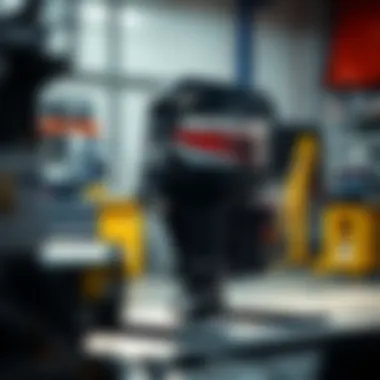
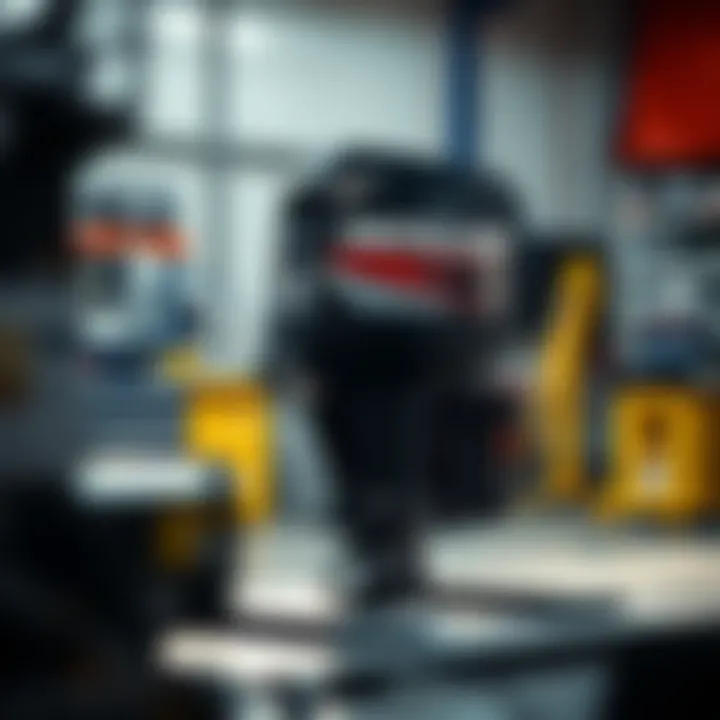
- Displacement: Typically around 500cc, this engine's size allows it to strike a balance between torque and speed.
- Fuel System: Most models utilize a carbureted system or electronic fuel injection, which delivers fuel in a precise manner, enhancing performance and reducing wastage.
- Ignition Type: A cdi (capacitor discharge ignition) system offers reliable starting and performance across varying conditions.
- Weight: This engine usually weighs between 90 to 110 pounds, contributing to its usability in smaller boats without compromising on power.
These specifications not only underpin the functionality of the unit but also influence the overall performance and operational costs throughout its lifespan. Therefore, a thorough understanding of these details is crucial for any user looking to maximize their investment.
Performance Characteristics
The performance characteristics of the 25 HP outboard engine greatly influence user satisfaction, with key elements that enhance both functionality and dependability on the water. Here are some critical features to consider:
- Acceleration: With the proper load, the engine can accelerate swiftly, making it suitable for activities like water skiing or fishing where quick movement is essential.
- Top Speed: Depending on the boat's design and weight, users can often achieve top speeds that flirt with 20 to 30 mph. This range is impressive for lighter crafts, making these engines a desirable choice for recreational users.
- Fuel Efficiency: One of the most significant factors for ongoing ownership costs. Models equipped with the latest fuel management technology can achieve remarkable miles per gallon, making long trips less burdensome on the wallet.
- Noise and Vibration: Reducing vibrations and noise is a critical design aspect. A well-maintained 25 HP outboard engine provides a relatively quiet and smooth operation, enhancing the overall boating experience.
These performance characteristics ensure that the 25 HP outboard motor remains a solid option for anyone seeking a blend of efficiency, power, and reliability on the water. Both new buyers and seasoned users can appreciate the nuances of these features, which are pivotal in tailoring the engine's usage to their specific requirements.
The understanding of the engine specifications and performance characteristics is essential for ensuring optimal performance and longevity in your 25 HP Mercury outboard motor.
Understanding the Lower Unit
The lower unit is a crucial component that embodies the very essence of an outboard motor's performance. Understanding this part can mean the difference between smooth sailing and turbulent waters. For those interested in the 25 HP Mercury outboards, grasping the dynamics of the lower unit opens up a world of possibilities for enhancement, maintenance, and troubleshooting. It's not just about knowing how it works; it's about appreciating its role in the broader context of boating and marine activities.
Purpose and Functionality
At its core, the lower unit operates like the transmission of a car; it plays a vital role in directing power from the engine to the propeller. It houses the gear assembly that adjusts the engine's rotational speed to a level suitable for propelling the boat through water. When considering the purpose of the lower unit, several specific aspects come into play.
- Power Transfer: The lower unit transfers engine power to the propeller effectively. Gear ratios help manage the engine’s RPMs, allowing for better control and fuel efficiency.
- Rudimentary Protection: It incorporates various safety features, such as the shear pin, which prevents damage to the propeller and the engine resulting from hitting underwater obstacles.
- Water Management: Additionally, the lower unit assists in funneling cooling water to the engine, highlighting the importance of maintaining a well-functioning system. Often, poor water circulation can lead to overheating, compromising the engine's longevity.
Understanding these functions is essential for both enthusiasts and experts, as it directly impacts performance and maintenance routines.
Key Components of the Lower Unit
Diving deeper into the lower unit reveals several components that work harmoniously to ensure its proper function. Each section serves a distinct role that, when understood, can lead to better maintenance and performance.
- Gearcase: The heart of the lower unit houses the gears that control propulsion. Its design ensures that power is transmitted efficiently from the engine to the propeller.
- Prop Shaft: This is what connects the gearcase to the propeller. A well-maintained prop shaft is critical for smooth operation; any wear or damage here can lead to performance issues.
- Water Pump: Positioned at the top of the lower unit, it plays an essential role in cooling the engine. Regular inspection can prevent nasty surprises out on the water.
- Anodes: These are sacrificial pieces of metal meant to protect against corrosion. It's wise to check them regularly, especially in saltwater environments, where they dissolve gradually to protect the more important parts.
- Seals and Gaskets: Essential for maintaining watertight integrity, these components prevent oil leaks and water ingress.
Understanding these components not only enhances the ability to maintain the lower unit effectively but also equips one with the knowledge needed to troubleshoot common issues. By knowing what each part does and how they interact, operators can make informed decisions about repairs and upgrades.
"In marine environments, knowledge is your best ally; understanding the lower unit can empower you to respond effectively to problems before they escalate."
Common Features of the Lower Unit
Understanding the common features of the lower unit in 25 HP Mercury outboard motors is crucial for anyone looking to optimize their marine experience. The efficiency and reliability of the engine largely depends on these features, which encompass different components that work in concert. A comprehensive grasp of these elements not only enhances performance but also aids in maintaining the longevity of the motor.
Gear Ratios
The gear ratios in the lower unit play an essential role in determining how well the outboard performs under different conditions. A higher gear ratio typically means more speed, which suits those who want to zip across the water, whereas a lower ratio proves more useful for hauling heavier loads or ensuring torque at lower speeds. The specifics of your needs dictate the ideal ratio:
- High Gear Ratio: Faster speeds, ideal for racing or swift transportation.
- Low Gear Ratio: Better torque, excellent for towing or navigating through rough waters.
The right gear ratio can significantly impact fuel efficiency as well. By understanding your boating habits, you can adjust or replace gears, ensuring that your engine runs more efficiently. Achieving that balance between performance and efficiency is key.
Cooling Systems
The cooling system in an outboard motor is vital. It helps prevent the engine from overheating, which can cause serious damage or even complete failure. Mercury outboards incorporate an innovative cooling system designed to keep temperatures in check while providing reliable operation. This system typically includes water intakes, which work to circulate coolant effectively. Here are a few points to note:
- Freshwater vs. Saltwater: The cooling system should perform well in both environments, but maintaining it as per its operating condition ensures longevity.
- Monitoring Temperature: Keeping an eye on temperature gauges can alert you to any cooling issues early on, preventing more significant troubles down the road.
By staying ahead with maintenance, such as flushing the cooling system and checking for blockages, you stand to greatly enhance the lifespan of the engine.
Propeller Compatibility
Finally, let's touch on propeller compatibility. A propeller that's well-matched to your lower unit can make the difference between a motor that runs smoothly and one that underperforms. Different types of propellers are designed for specific tasks and conditions. Key factors to consider include:
- Diameter and Pitch: The right diameter affects how much water the propeller can push, while pitch controls speed. Select propellers to match your intended use—whether fishing, cruising, or racing.
- Material Composition: Stainless steel offers more durability, while aluminum tends to be lighter and less expensive. Your choice should align with how often you plan to replace or repair your propeller.
It's wise to consult manufacturer's recommendations and even tap into online forums like Reddit or specialized boating websites for tips from fellow enthusiasts.
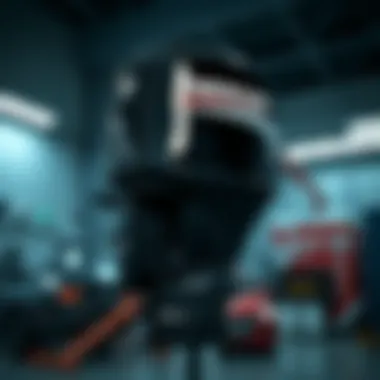

With these common features in mind, you equip yourself with the knowledge needed to make informed decisions about your 25 HP Mercury outboard motor. It's all about ensuring that each component works effectively, promoting both performance and longevity.
Maintenance of the Lower Unit
Regular maintenance of the lower unit is crucial for ensuring the longevity and efficiency of the 25 HP Mercury outboard motor. The lower unit is often exposed to harsh marine environments, with water, sand, and debris potentially affecting performance. Routine care not only helps to avoid costly repairs but also keeps the boat running at optimal levels, ensuring your time on the water is enjoyable and trouble-free.
Routine maintenance also builds confidence in the equipment. An unchecked lower unit can lead to sudden failures, making it imperative to establish a consistent schedule for checks and repairs. By understanding what maintenance entails, users can proactively prevent wear and tear that might arise from neglect.
Routine Maintenance Practices
Performing routine maintenance on the lower unit involves several key practices. These practices might seem simple, but they are effective when executed properly. Here are some recommended approaches:
- Regular Inspection: Checking the lower unit for signs of water intrusion, damage, or corrosion is essential. This should occur before each use and whenever the boat is brought in for major service.
- Fluid Changes: Changing the gear oil is crucial. It is best to do this at least once a year or after every 100 hours of use. Contaminants build up in the oil over time, risking gearbox integrity.
- Cleaning: Marine growth and debris can accumulate on the propeller and lower unit. Regular cleaning prevents unnecessary drag and potential damage. Using a brush and appropriate cleaning products can help facilitate this process.
- Shaft Lubrication: The drive shaft should also be greased to prevent wear. Using marine-grade grease suitable for outboard motors can ensure smooth operation.
- Visual Checks: Look for cracks, signs of rust, or any physical deformities in the housing. Addressing these issues sooner rather than later can save repairs down the road.
Incorporating these practices into your routine not only keeps the lower unit functioning optimally, but also sets the tone for treating your outboard with the respect it deserves.
Common Maintenance Questions
When it comes to the maintenance of the lower unit, some questions often surface among boat owners. Here are a few common inquiries along with straightforward answers:
- How often should I change the gear oil?
Recommended frequency is every 100 hours of use or at least once a year. - What type of gear oil should I use?
Always refer to the owner’s manual for specifications. Typically, a high-quality marine gear oil is best. - Is it necessary to replace the seals?
Yes, seals should be checked regularly; replacing them as needed is crucial for preventing water intrusion. - Can I perform maintenance myself?
Many tasks can be done at home with the right tools and basic skills. However, more complex issues may require a professional’s expertise. - What are signs that the lower unit needs attention?
Unusual noises, vibrations, or a sudden decrease in performance are clear indicators that a checkup is necessary.
These questions reveal the vital aspects of lower unit maintenance and the ongoing effort required to keep it manageable.
"A well-maintained lower unit is the backbone of a reliable outboard. It keeps you moving while ensuring safety and efficiency."
By incorporating a solid maintenance regime, you’re not just keeping your motor healthy; you’re ensuring a smoother ride and greater peace of mind.
Common Issues with the Lower Unit
When it comes to the lower unit of the 25 HP Mercury outboards, understanding the common issues that can arise is crucial. This component, as a vital link between the engine and the propeller, bears the brunt of various operational stresses. The performance of the outboard motor hinges on the health of the lower unit. Ignoring potential problems can lead to costly repairs or a complete motor failure.
Identifying Failures
Recognizing when something's amiss with your lower unit is the first step in preventing further damage. Various signs signal that a unit is in distress. A few notable indicators include:
- Unusual Noises: If there are any strange sounds, such as grinding or clunking when in gear, it might suggest gear issues.
- Fluid Leaks: Transmission fluid leaking from the lower unit often indicates a seal problem. Check frequently for oily puddles beneath the engine.
- Overheating: Persistent overheating can result from blocked cooling passages or malfunctioning waters pumps. Keep an eye on the temperature gauge.
- Reduced Performance: If the outboard is not reaching its usual speed or revs, it can point to propeller or gear issues.
Making timely assessments can save you from a hard day and reduce downtime on the water.
Troubleshooting Tips
Once you identify a potential issue, tackling it promptly is helpful for the longevity of the motor. Here are some troubleshooting steps that can help you narrow down the problems:
- Inspect Both Gear Oil and its Levels: Dark or milky oil often hints that there's water coming into the unit, while low levels might indicate a leak.
- Check the Anodes: Inspect the sacrificial anodes for wear. If they're worn out, replace them as they protect against corrosion.
- Gear Teeth Inspection: If noisy operation is present, consider reviewing the gear teeth for damage or wear.
- Examine the Propeller: Look for dings, bends, or even detached blades on the propeller which could affect performance.
- Seek Expert Help if Necessary: Not every problem is meant to be solved alone. If issues persist beyond basic checks, bringing in an expert can save time and headaches.
A stitch in time saves nine. Addressing issues before they escalate can save both time and money.
By actively monitoring for any signs of trouble and adopting some key troubleshooting techniques, you can considerably extend the life of the lower unit on your 25 HP Mercury outboard. Stay vigilant, and the waters can remain yours to enjoy.
Repairing the Lower Unit
Repairing the lower unit of a 25 HP Mercury outboard is not just a maintenance task but often a necessity to keep the engine running smoothly and reliably. The lower unit houses essential components such as the gearbox, propeller shaft, and oil seal, all of which are critical for the overall performance of the motor. An issue in the lower unit could lead to ineffective propulsion, unheard noises, or even complete breakdowns during critical moments on the water. Recognizing the importance of this unit helps in understanding how delays in repairs could escalate problems and costs, which no boat owner wants to face.
Benefits of Repairing the Lower Unit
- Improved Performance: A functioning lower unit ensures optimal operation, enhancing the overall performance of the engine.
- Cost Efficiency: Quick repairs can prevent minor issues from expanding into major, costly repairs.
- Safety: A well-maintained lower unit minimizes risks while navigating waters and ensures safety for all aboard.
Considerations: When engaging with the repair process, it is crucial to have the right tools and knowledge. Moreover, understand that some problems may be fixed with basic mechanical skills, while others may require specialized techniques or expertise. Hence, weighing your options before diving into repairs is a good approach.
Common Repair Techniques
When it comes to repairing the lower unit of a 25 HP Mercury outboard, several common techniques stand out. Understanding these can empower you to manage repairs effectively:


- O-ring Replacement: Replace the o-rings if there’s any sign of leaking. This is often a straightforward fix that prevents water ingress into the gear case.
- Gear Oil Change: Regularly changing the gear oil not only enhances the lifespan of the lower unit but is a vital diagnostic method. Contaminated oil can indicate more severe internal problems.
- Seal Inspection: Checking the seals for wear and tear can save unnecessary hassle. Inspect for any signs of deterioration or cracks.
- Propeller Repair or Replacement: A bent or damaged propeller can lead to massive performance issues. Identifying and fixing these not only improves efficiency but also protects other components from strain.
- Aligning Driveshaft: An improper alignment can cause further wear on gears. Ensuring it’s aligned correctly may require professional tools but is essential for smooth operation.
When to Seek Professional Help
Even the most experienced DIY enthusiasts may reach a point where a repair exceeds their skill set. Here are some indicators that it’s time to seek professional assistance:
- Complex Gearbox Issues: When internal problems with the gearbox present themselves, it may require specific tools and skills that are best left to professionals.
- Persistent Leaks: If replacing o-rings and seals doesn't eliminate the leak, further inspection might be necessary to address the underlying problem.
- Unusual Noises during Operation: Grinding, clicking, or unusual sounds often point to deeper issues that require professional diagnostic capabilities.
- Unexplained Performance Drop: If your unit is not performing as expected and standard maintenance hasn’t helped, consulting an expert is wise.
- Time Constraints: Sometimes, the best course of action, even for knowledgeable boaters, is time management. If you're pressed for time, a professional can return the unit to you faster and with reliability.
"An informed boater is a safe boater, understanding when to DIY and when to call the pros can save you headaches on the water."
In summation, the lower unit's repair is a vital component of maintaining a Mercury outboard’s overall efficiency and functionality. From common techniques that can be tackled independently to knowing when it’s best to consult a professional, this knowledge ultimately contributes significantly to more enjoyable and safer marine adventures. For more guidance, the following resources may help: Wikipedia and Reddit.
Upgrading and Modifying the Lower Unit
Upgrading and modifying the lower unit of a 25 HP Mercury outboard motor is more than just a hobby; it's a way to enhance performance and adapt the motor to individual needs. As time progresses and technology advances, boat enthusiasts find themselves drawn to the idea of customizing their lower units, pushing the boundaries of what a standard outboard can deliver. This section dives into the significance of upgrades and modifications, highlighting distinct elements that contribute to improved boating experiences.
Performance Enhancements
To squeeze out that extra bit of power and efficiency, many boat owners explore different avenues for performance enhancements. One significant area is the gear ratio. By switching to a different gear ratio, you might optimize the motor for better acceleration or top speed, depending on your needs and boating conditions. Here’s a breakdown of potential performance upgrades:
- Replacing the Propeller: A different propeller can dramatically change the way your boat handles and performs. Whether you seek more thrust during takeoff or wish to increase your top speed, the right propeller is key.
- Servo Trim Systems: Incorporating digital trim systems can improve fuel efficiency and handling by allowing precise adjustments to the motor’s trim angle.
- Upgraded Cooling Systems: Enhancing the cooling system can prevent overheating during prolonged use, ensuring reliability and longevity.
Investing in these enhancements can lead to a more robust performance on the water, allowing boaters to adapt their motors to specific needs such as fishing, racing, or leisurely cruising.
Customization Options
Customization options for the lower unit not only focus on performance but also on aesthetics and personal preference. The goal is to make your outboard feel uniquely yours while enhancing its capabilities. Some interesting customization options include:
- Color Schemes and Decals: Many enthusiasts choose unique designs or colors for their motors to stand out on the water.
- Aftermarket Skeg Guards: These provide additional protection for the lower unit, preventing damage from debris, which is a worthwhile investment for those navigating rocky waters.
- Hydraulic Steering Upgrades: For precise steering and handling, upgrading to hydraulic systems can offer more responsiveness and less physical strain when maneuvering.
When considering these modifications, think about how you typically use your boat. For example, if you're often fishing in shallow waters, enhancing your lower unit with a skeg guard could pay dividends in protecting your investment.
"Investing in your lower unit is like investing in your passion for boating. It's not just about performance; it's about refining your experience on the water."
Future Trends in Outboard Technology
The realm of outboard motors, specifically the 25 HP Mercury outboards, is undergoing significant evolution. It's not just about horsepower or speed anymore. Future trends in outboard technology are steering the industry toward innovations that prioritize efficiency, sustainability, and user experience. Understanding these trends is crucial for boating enthusiasts as they provide insights into what’s coming next and how it can affect operational performance, maintenance practices, and overall longevity of the motors.
Emerging Technologies
As we look around the corner, several emerging technologies stand poised to redefine how we view outboard motors. One standout area is electric propulsion. The demand for quieter and cleaner alternatives is nudging manufacturers to develop electric outboards that can deliver performance with minimal environmental impact. Imagine gliding through a serene lake with only the whisper of the wind, unbothered by engine noise. Compared to traditional fuel-powered engines, electric outboards not only promise maintenance savings but also contribute to reducing carbon footprints.
In addition, the integration of sophisticated smart technologies is rapidly changing the landscape. Features like real-time diagnostics and GPS tracking are helping boaters monitor performance and receive alerts on potential malfunctions. This data-driven approach allows for proactive maintenance. For example, if a lower unit is running hot, the system can alert the captain before catastrophic failures occurs. Such technology bridges the gap between the mechanical and digital, making boating safer and more enjoyable.
- Key Points on Emerging Technologies:
- Electric propulsion systems for sustainability
- Real-time diagnostics for enhanced performance monitoring
- Smart features for seamless navigation and operation
Environmental Considerations
As the boating community grows more eco-conscious, understanding environmental considerations becomes paramount. Regulations around emissions are tightening globally, compelling manufacturers to innovate cleaner designs. New developments focus on reducing emissions without sacrificing performance. The transition to more sustainable materials in manufacturing is also noteworthy. Using biodegradable composites and recyclable materials is becoming more common, which resonates well with the environment-conscious consumer.
Additionally, the shift toward hybrid systems creates a balance between traditional and alternative fuels. These systems can run on electric power at lower speeds, saving fuel and reducing emissions, and switch to gasoline for higher speeds as needed. This versatility means greater flexibility for users while also adhering to environmental regulations, often without compromising performance.
"As we advance, it's not just about crafting more powerful engines, but smarter and cleaner ones that keep our waters pristine."
Ending
The significance of the lower unit for 25 HP Mercury outboards cannot be overstated. Proper understanding of this component greatly enhances both performance and longevity of the engine. This article has explored a wide range of aspects surrounding the lower unit, weaving through its design and functionality. These elements are not merely academic; they offer practical benefits for everyday users.
Summary of Key Points
- Functionality: The lower unit plays a pivotal role in transforming engine power into effective propulsion. Recognizing its purpose enhances maintenance practices and repairs.
- Common Issues: Knowing the typical failures—like gear issues or seal leaks—can help users prevent major breakdowns. Early detection can save both time and money.
- Maintenance Recommendations: Regular inspections and adherence to routine maintenance practices are vital. Keeping an eye on fluid levels and ensuring proper lubrication can extend the unit's lifespan significantly.
- Upgrades: Potential enhancements can further optimize performance. Users should be open to exploring customization options to better suit their boating needs.
Final Thoughts
Navigating the intricacies of the lower unit is not just for seasoned mechanics. Enthusiasts and everyday users alike can benefit from employing best practices based on insights found in this article. A well-managed lower unit fosters not just better performance, but also a sense of confidence in the craft itself. When it comes down to it, understanding these crucial components ultimately translates into safer and more enjoyable boating experiences.
"An ounce of prevention is worth a pound of cure."















